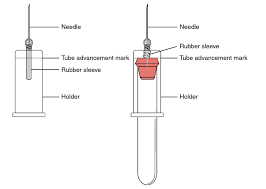Which of the following actions is included in aseptic technique when a phlebotomist is performing a venipuncture on a patient?
Disposing of contaminated materials
Performing hand hygiene once daily
Completing quality control procedures
Cleansing skin with sodium hypochlorite
The Correct Answer is D
Choice A Reason:
Disposing of contaminated materials is a part of standard infection control practices. While it is important to dispose of materials that may be contaminated with blood or bodily fluids properly, this action is not specific to the aseptic technique used during venipuncture.
Choice B Reason:
Performing hand hygiene once daily is not sufficient for maintaining aseptic technique. Aseptic technique requires hand hygiene before and after each patient contact, especially before procedures like venipuncture to prevent the transmission of pathogens.
Choice C Reason:
Completing quality control procedures is an essential part of laboratory practice and patient safety but is not directly related to the aseptic technique of venipuncture. Quality control ensures the accuracy and reliability of test results rather than preventing infection.
Choice D Reason:
Cleansing the skin with sodium hypochlorite, or a similar disinfectant, is a critical step in aseptic technique for venipuncture. This action reduces the microbial load on the skin, thereby minimizing the risk of introducing pathogens into the bloodstream during needle insertion.
Nursing Test Bank
Naxlex Comprehensive Predictor Exams
Related Questions
Correct Answer is A
Explanation
Choice A Reason:
The evacuated tube system is designed for the collection of multiple blood specimens using interchangeable tubes. This system utilizes a double-pointed needle, one end of which goes into the patient's vein and the other into a vacuum tube. As the blood is drawn, it automatically fills the tube until the vacuum is exhausted. The phlebotomist can then easily replace the filled tube with another without removing the needle from the patient's vein, allowing for multiple samples to be taken during a single venipuncture.
Choice B Reason:
The hypodermic needle and syringe system is typically used for manual blood draws when the evacuated tube system is not suitable, such as with small or fragile veins. This system does not use interchangeable tubes; instead, the blood is drawn into a syringe and then transferred into the appropriate tubes, which can be time-consuming and increase the risk of hemolysis or contamination.
Choice C Reason:
A winged infusion set, also known as a butterfly needle, is often used for patients with difficult veins. Like the hypodermic needle and syringe system, it does not inherently allow for the use of interchangeable multi-sample tubes. Blood is collected into a syringe or a single tube attached to the butterfly needle, and changing tubes usually requires a new puncture for each sample.
Choice D Reason:
The lancet microcollection system is used for capillary blood collection, typically from a fingerstick or heelstick. It is used for small volume samples and does not accommodate interchangeable multi-sample tubes. This method is commonly used for pediatric patients or when only a small amount of blood is needed.

Correct Answer is A
Explanation
Choice A reason:
When encountering a patient who appears motionless and cyanotic, the first action should be to assess their level of consciousness. Asking loudly if they are okay can help determine if the patient is responsive or unresponsive. If there is no response, this indicates that the patient may be unconscious and requires further immediate assessment and potential intervention.
Choice B reason:
The head-tilt-chin-lift maneuver is used to open the airway of an unresponsive patient who is not suspected of having a spinal injury. However, this is not the first step. Before performing any maneuvers, it is essential to determine the patient's level of consciousness and whether they are breathing.
Choice C reason:
Administering rescue breaths is part of the process of cardiopulmonary resuscitation (CPR), which is only initiated after confirming that the patient is unresponsive and not breathing normally. This step comes after checking for responsiveness and breathing.
Choice D reason:
Looking, listening, and feeling for breathing movements is part of the assessment to determine if the patient is breathing normally. This is done after establishing unresponsiveness but before initiating CPR. It is a critical step, but it follows after confirming that the patient does not respond to verbal stimuli.
Whether you are a student looking to ace your exams or a practicing nurse seeking to enhance your expertise , our nursing education contents will empower you with the confidence and competence to make a difference in the lives of patients and become a respected leader in the healthcare field.
Visit Naxlex, invest in your future and unlock endless possibilities with our unparalleled nursing education contents today
Report Wrong Answer on the Current Question
Do you disagree with the answer? If yes, what is your expected answer? Explain.
Kindly be descriptive with the issue you are facing.
